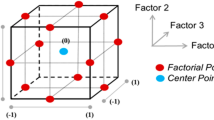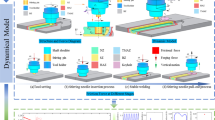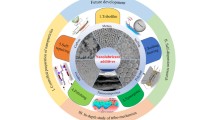Abstract
Submerged Friction Stir Welding is a modification of the friction stir welding process in which the water as the coolant is employed to standardize the temperature. It is considered as a green and environmentally friendly welding technology because of low energy consumption, no gas emission, and no need for consumable material. It is applied to structural purposes like oil platforms and pipelines, or in industrial and laboratories for enhancing the weld strength. This review paper is classified into three categories, the first one studies the preceding experimental investigations, the second one is modelling/optimization, and the third one is current status and development of submerged friction stir welding. The experimental results of the previous research findings in submerged friction stir welded sample with performance characteristics, tensile properties, microhardness, fracture analysis and corrosion resistance, macro/microstructure analysis on the various materials are discussed. This review articles concludes with recommendations for future research exertion.



















Similar content being viewed by others
References
Mishra, R. S., & Ma, Z. Y. (2005). Friction stir welding and processing. Materials Science and Engineering: R: Reports, 50(1–2), 1–78.
Mishra, R. S., De, P. S., & Kumar, N. (2014). Friction stir welding and processing: Science and engineering. Berlin: Springer. (ISBN- 978-3-319-07043-8).
Liu, X., Lan, S., & Ni, J. (2014). Analysis of process parameters effects on friction stir welding of dissimilar aluminum alloy to advanced high strength steel. Materials and Design, 59, 50–62.
Zhang, H. J., Liu, H. J., & Lei, Y. U. (2013). Thermal modeling of underwater friction stir welding of high strength aluminum alloy. Transactions of Nonferrous Metals Society of China, 23(4), 1114–1122.
Mofid, M. A., Abdollah-Zadeh, A., & Ghaini, F. M. (2012). The effect of water cooling during dissimilar friction stir welding of Al alloy to Mg alloy. Materials and Design, 36, 161–167.
Wang, B. B., Chen, F. F., Liu, F., Wang, W. G., Xue, P., & Ma, Z. Y. (2017). Enhanced mechanical properties of friction stir welded 5083Al-H19 joints with additional water cooling. Journal of Materials Science and Technology, 33(9), 1009–1014.
Zhang, H. J., Liu, H. J., & Yu, L. (2012). Effect of water cooling on the performances of friction stir welding heat-affected zone. Journal of Materials Engineering and Performance, 21(7), 1182–1187.
Fratini, L., Buffa, G., & Shivpuri, R. (2009). In-process heat treatments to improve FS-welded butt joints. The International Journal of Advanced Manufacturing Technology, 43(7–8), 664.
Fratini, L., Buffa, G., & Shivpuri, R. (2010). Mechanical and metallurgical effects of in process cooling during friction stir welding of AA7075-T6 butt joints. Acta Materialia, 58, 2056–2067.
Sakurada, D., Katoh, K., & Tokisue, H. (2002). Underwater friction welding of 6061 aluminum alloy. Journal of Japan Institute of Light Metals, 52(2), 2.
Douglas Hofmann, C., & Kenneth Vecchio, S. (2005). Submerged friction stir processing (SFSP): An improved method for creating ultra-fine-grained bulk materials. Materials Science and Engineering, 402, 234–241.
Jeon, C. H., Jeong, Y. H., Seo, J. J., Tien, H. N., Hong, S. T., Yum, Y. J., et al. (2014). Material properties of graphene/aluminum metal matrix composites fabricated by friction stir processing. International Journal of Precision Engineering and Manufacturing, 15(6), 1235–1239.
Kim, W. K., Won, S. T., & Goo, B. C. (2010). A study on mechanical characteristics of the friction stir welded A6005-T5 extrusion. International Journal of Precision Engineering and Manufacturing, 11(6), 931–936.
Wahid, M. A., & Siddiquee, A. N. (2018). Review on underwater friction stir welding: A variant of friction stir welding with great potential of improving joint properties. Transactions of Nonferrous Metals Society of China, 28(2), 193–219.
Papahn, H., Bahemmat, P., Haghpanahi, M., & Sommitsch, C. (2015). Study on governing parameters of thermal history during underwater friction stir welding. The International Journal of Advanced Manufacturing Technology, 78(5–8), 1101–1111.
Bloodworth, T. S. (2009). On the immersed friction stir welding of AA6061-T6: A metallurgic and mechanical comparison to friction stir welding. Doctoral Dissertation, Vanderbilt University.
Kishta, E. E., & Darras, B. (2016). Experimental investigation of underwater friction-stir welding of 5083 marine-grade aluminum alloy. Proceedings of the Institution of Mechanical Engineers, Part B: Journal of Engineering Manufacture, 230(3), 458–465.
Wang, Q., Zhao, Z., Zhao, Y., Yan, K., & Zhang, H. (2015). The adjustment strategy of welding parameters for spray formed 7055 aluminum alloy underwater friction stir welding joint. Materials and Design, 88, 1366–1376.
Fu, R. D., Sun, R. C., Zhang, F. C., & Liu, H. J. (2012). Improvement of formation quality for friction stir welded joints. Welding Journal, 91(6), 169–173.
Xue, P., Xiao, B. L., Zhang, Q., & Ma, Z. Y. (2011). Achieving friction stir welded pure copper joints with nearly equal strength to the parent metal via additional rapid cooling. Scripta Materialia, 64(11), 1051–1054.
Liu, H. J., Zhang, H. J., & Yu, L. (2011). Homogeneity of mechanical properties of underwater friction stir welded 2219-T6 aluminum alloy. Journal of Materials Engineering and Performance, 20, 1419–1422.
Fu, Zeng-qiang Sun, Sun, Rui-cheng, Li, Ying, Liu, Hui-jie, & Liu, Lei. (2011). Improvement of weld temperature distribution and mechanical properties of 7050 aluminum alloy butt joints by submerged friction stir welding. Materials and Design, 32, 4825–4831.
Zhao, Y., Lu, Z., Yan, K., & Huang, L. (2015). Microstructural characterizations and mechanical properties in underwater friction stir welding of aluminum and magnesium dissimilar alloys. Materials & Design (1980–2015), 65, 675–681.
Sabari, S. S., Malarvizhi, S., & Balasubramanian, V. (2016). The effect of pin profiles on the microstructure and mechanical properties of underwater friction stir welded AA2519-T87 aluminium alloy. International Journal of Mechanical and Materials Engineering, 11(1), 5.
Xu, X., Yang, X., Zhou, G., & Tong, J. (2012). Microstructures and fatigue properties of friction stir lap welds in aluminum alloy AA6061-T6. Materials and Design, 35, 175–183.
Sabari, S. S., Malarvizhi, S., & Balasubramanian, V. (2016). Characteristics of FSW and UWFSW joints of AA2519-T87 aluminium alloy: Effect of tool rotation speed. Journal of Manufacturing Processes, 22, 278–289.
Liu, H. J., Zhang, H. J., & Yu, L. (2011). Effect of welding speed on microstructures and mechanical properties of underwater friction stir welded 2219 aluminum alloy. Materials and Design, 32, 1548–1553.
Zhao, Y., Jiang, S., Yang, S., Lu, Z., & Yan, K. (2016). Influence of cooling conditions on joint properties and microstructures of aluminum and magnesium dissimilar alloys by friction stir welding. The International Journal of Advanced Manufacturing Technology, 83(1–4), 673–679.
Azarafza, R., Rabieifar, A., Rezaei, A., & Nategh, S. (2017). The effect of travel and rotational speeds on the mechanical properties of Al2024 in underwater friction stir welding. Journal of Environmental Friendly Materials, 1(2), 15–22.
Lokesh, R., Kumar, V. S., Rathinasuriyan, C., & Sankar, R. (2015). Optimization of process parameters: tool pin profile, rotational speed and welding speed for submerged friction stir welding of AA6063 alloy. International Journal of Technical Research and Applications, 12, 35–38.
Hui-jie, L. I. U., & Li, Z. H. O. U. (2010). Microstructural zones and tensile characteristics of friction stir welded joint of TC4 titanium alloy. Transactions of the Nonferrous Metals Society of China, 20, 1873–1878.
Liu, H. J., & Feng, X. L. (2013). Effect of post-processing heat treatment on microstructure and microhardness of water-submerged friction stir processed 2219-T6 aluminum alloy. Materials and Design, 47, 101–105.
Zhang, H. J., Liu, H. J., & Yu, L. (2011). Microstructure and mechanical properties as a function of rotation speed in underwater friction stir welded aluminum alloy joints. Materials and Design, 32, 4402–4407.
Rathinasuriyan, C., & Senthil Kumar, V. S. (2018). Submerged friction stir welding of 6061-T6 aluminium alloy under different water heads. Journal of Material Research, 21(6), 1–12.
Fontana, M. G., Corrosion engineering, materials technology of the chemical process industries Inc. The Ohio state University, ISBN 0-07-100360-6.
Wang, Q., Zhao, Y., Yan, K., & Lu, S. (2015). Corrosion behavior of spray formed 7055 aluminum alloy joint welded by underwater friction stir welding. Materials and Design, 68, 97–103.
Rathinasuriyan, C., Kumar, V. S., & Shanbhag, A. G. (2014). Radiography and corrosion analysis of sub-merged friction stir welding of AA6061-T6 alloy. Procedia Engineering, 97, 810–818.
Clark, T. D. (2005). An analysis of microstructure and corrosion resistance in underwater friction stir welded 304L stainless steel. Scholars Archive. ISSN 2572-4479.
Chai, F., Zhang, D., & Li, Y. (2015). Microstructures and tensile properties of submerged friction stir processed AZ91 magnesium alloy. Journal of Magnesium and Alloys, 3(3), 203–209.
Cao, G., Zhang, D., Zhang, W., & Qiu, C. (2015). Microstructure evolution and mechanical properties of Mg–Nd–Y alloy in different friction stir processing conditions. Journal of Alloys and Compounds, 636, 12–19.
Heirani, F., Abbasi, A., & Ardestani, M. (2017). Effects of processing parameters on microstructure and mechanical behaviors of underwater friction stir welding of Al5083 alloy. Journal of Manufacturing Processes, 25, 77–84.
Sabari, S. S., Malarvizhi, S., Balasubramanian, V., & Reddy, G. M. (2016). Experimental and numerical investigation on under-water friction stir welding of armour grade AA2519-T87 aluminium alloy. Defence Technology, 12(4), 324–333.
Lin, H., Wu, Y., Liu, S., & Zhou, X. (2018). Effect of cooling conditions on microstructure and mechanical properties of friction stir welded 7055 aluminium alloy joints. Materials Characterization, 141, 74–85.
Tan, Y. B., Wang, X. M., Ma, M., Zhang, J. X., Liu, W. C., Fu, R. D., et al. (2017). A study on microstructure and mechanical properties of AA 3003 aluminum alloy joints by underwater friction stir welding. Materials Characterization, 127, 41–52.
Wang, K. S., Wu, J. L., Wang, W., Zhou, L. H., Lin, Z. X., & Kong, L. (2012). Underwater friction stir welding of ultrafine grained 2017 aluminum alloy. Journal of Central South University, 19(8), 2081–2085.
Wang, Q., Zhao, Z., Zhao, Y., Yan, K., Liu, C., & Zhang, H. (2016). The strengthening mechanism of spray forming Al–Zn–Mg–Cu alloy by underwater friction stir welding. Materials and Design, 102, 91–99.
Das, H., Mondal, M., Hong, S. T., Chun, D. M., & Han, H. N. (2018). Joining and fabrication of metal matrix composites by friction stir welding/processing. International Journal of Precision Engineering and Manufacturing-Green Technology, 5(1), 151–172.
Kim, K. H., Bang, H. S., Ro, C. S., & Bang, H. S. (2017). Influence of preheating source on mechanical properties and welding residual stress characteristics in ultra thin ferritic stainless steel hybrid friction stir welded joints. International Journal of Precision Engineering and Manufacturing-Green Technology, 4(4), 393–400.
Shojaeefard, M. H., Akbari, M., & Asadi, P. (2014). Multi objective optimization of friction stir welding parameters using FEM and neural network. International journal of precision engineering and manufacturing, 15(11), 2351–2356.
Ghetiya, N. D., & Patel, K. M. (2015). Prediction of tensile strength and microstructure characterization of immersed friction stir welding of aluminium alloy AA2014-T4. Indian Journal of Engineering & Materials Sciences, 22, 133–140.
Hajinezhad, M., & Azizi, A. (2016). Numerical analysis of effect of coolant on the transient temperature in underwater friction stir welding of Al6061-T6. The International Journal of Advanced Manufacturing Technology, 83(5–8), 1241–1252.
Yazdipour, A., & Dehghani, K. (2009). Modeling the microstructural evolution and effect of cooling rate on the nanograins formed during the friction stir processing of Al5083. Materials Science and Engineering A, 527(1–2), 192–197.
Rathinasuriyan, C., & Kumar, V. S. (2016). Modelling and optimization of submerged friction stir welding parameters for AA6061-T6 alloy using RSM. Kovove Materially Metallic Materials, 54, 297–304.
Zhang & Huijie Liuv. (2013). Mathematical model and optimization for underwater friction stir welding of a heat-treatable aluminum alloy. Materials and Design, 45, 206–211.
Santhanam, S. K. V., Rathinaraj, L., Chandran, R., & Ramaiyan, S. (2015). Multi response optimization of submerged friction stir welding process parameters using TOPSIS approach. In ASME 2015 International Mechanical Engineering Congress and Exposition (pp. V02BT02A032-V02BT02A032). American Society of Mechanical Engineers.
Santhanam, S. K. V., Ramaiyan, S., Rathinaraj, L., & Chandran, R. (2016). ‘Multi Response Optimization of Submerged Friction Stir Welding Process Parameters Using Grey Relational Analysis’, In ASME 2016 International Mechanical Engineering Congress and Exposition (pp. V002T02A075-V002T02A075). American Society of Mechanical Engineers.
Gao, J., Shen, Y., Zhang, J., & Xu, H. (2014). Submerged friction stir weld of polyethylene sheets. Journal of Applied Polymer Science, 131(22), 41059–41066.
Dumpala, L., Chintada, L. M. K., Deepu, D., & Yadav, P. K. (2017). Study of mechanical properties of aluminium alloys on normal friction stir welding and underwater friction stir welding for structural applications. World Academy of Science, Engineering and Technology, International Journal of Mechanical, Aerospace, Industrial, Mechatronic and Manufacturing Engineering, 11(7), 1337–1341.
Baillie, P., Campbell, S. W., Galloway, A. M., Cater, S. R., & McPherson, N. A. (2015). Friction stir welding of 6 mm thick carbon steel underwater and in air. Science and Technology of Welding and Joining, 20(7), 585–593.
Gao, J., Li, C., Shilpakar, U., & Shen, Y. (2016). Microstructure and tensile properties of dissimilar submerged friction stir welds between HDPE and ABS sheets. The International Journal of Advanced Manufacturing Technology, 87(1–4), 919–927.
Jalili, N., Tabrizi, H. B., & Hosseini, M. M. (2016). Experimental and numerical study of simultaneous cooling with CO2 gas during friction stir welding of Al-5052. Journal of Materials Processing Technology, 237, 243–253.
Zhang, J., Shen, Y., Yao, X., Xu, H., & Li, B. (2014). Investigation on dissimilar underwater friction stir lap welding of 6061-T6 aluminum alloy to pure copper. Materials and Design, 64, 74–80.
Stewart, W. C. (2011). Feasibility of underwater friction stir welding of HY-80 steel. Monterey: Naval Postgraduate School.
Mehta, K. P., & Badheka, V. J. (2017). Hybrid approaches of assisted heating and cooling for friction stir welding of copper to aluminum joints. Journal of Materials Processing Technology, 239, 336–345.
Mahto, R. P., Gupta, C., Kinjawadekar, M., Meena, A., & Pal, S. K. (2019). Weldability of AA6061-T6 and AISI 304 by underwater friction stir welding. Journal of Manufacturing Processes, 38, 370–386.
Fleming, P., Bloodworth, T., Lammlein, D., Strauss, A., & Cook, G. (2012). Hydrogen generation for sensing and control in submerged friction stir welding. Proceedings of the Institution of Mechanical Engineers, Part L: Journal of Materials: Design and Applications, 226(1), 72–75.
Garg, T., Mathur, P., Singhal, V., Jain, C., & Gupta, P. (2014). Underwater friction stir welding: An overview. International Review of Applied Engineering Research, 4(2), 165–170.
Rathinasuriyan, C., & Senthil Kumar, V. S. (2015). Submerged friction stir welding and processing: Insights of other researchers. International Journal of Applied Engineering Research, 10(8), 6530–6536.
Zhang, H., & Liu, H. (2012). Characteristics and formation mechanisms of welding defects in underwater friction stir welded aluminum alloy. Metallography, Microstructure, and Analysis, 1(6), 269–281.
Rouhi, S., Mostafapour, A., & Ashjari, M. (2016). Effects of welding environment on microstructure and mechanical properties of friction stir welded AZ91C magnesium alloy joints. Science and Technology of Welding and Joining, 21(1), 25–31.
Acknowledgements
The authors gratefully acknowledge the Science & Engineering Research Board, Department of Science and Technology (SERB-DST), New Delhi, India, for their financial assistance to conduct the research work through project no. SR/S3/MERC/0092/2011. The authors are grateful to the University Grants Commission (UGC), New Delhi, India for granting funds through project no.RGNF-2015-17-TAM-1232.
Author information
Authors and Affiliations
Corresponding author
Ethics declarations
Conflict of interest
On behalf of all authors, the corresponding author states that there is no conflict of interest.
Additional information
Publisher's Note
Springer Nature remains neutral with regard to jurisdictional claims in published maps and institutional affiliations.
Rights and permissions
About this article
Cite this article
Rathinasuriyan, C., Pavithra, E., Sankar, R. et al. Current Status and Development of Submerged Friction Stir Welding: A Review. Int. J. of Precis. Eng. and Manuf.-Green Tech. 8, 687–701 (2021). https://doi.org/10.1007/s40684-020-00187-6
Received:
Revised:
Accepted:
Published:
Issue Date:
DOI: https://doi.org/10.1007/s40684-020-00187-6




